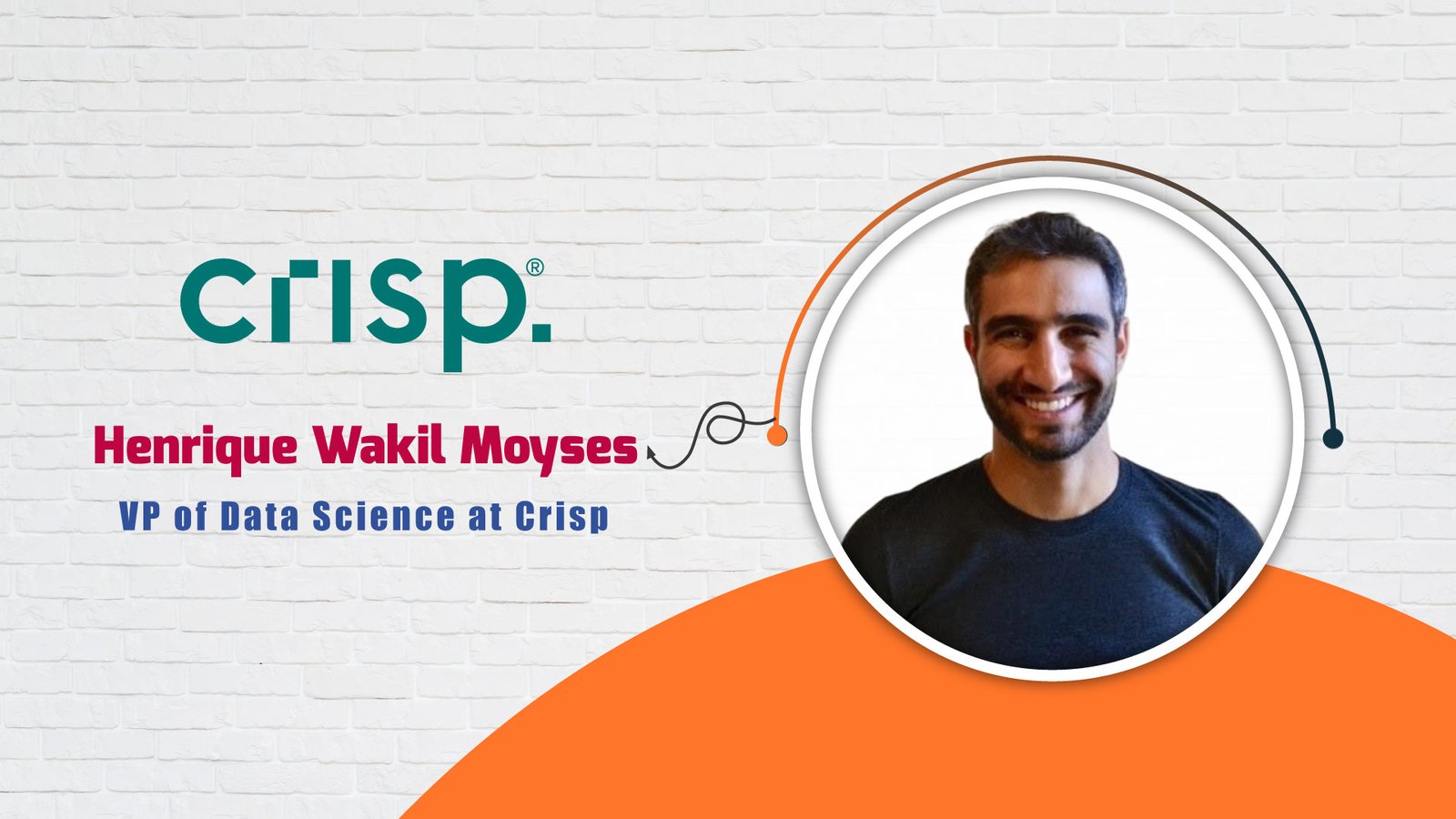Solving retail complexity with AI – a deep look at how modern data science clears the path for confident, real-time decision-making in CPG.
Henrique, your career journey is quite impressive! Could you share a bit about your background and what led you to your current role as VP of Data Science at Crisp?
My journey began as a physicist for almost a decade, beginning in Brazil and then in New York City at NYU, where I continued my academic studies and attained my PhD. I have focused on statistical physics, biophysics, and materials science, which have been instrumental in shaping my approach to data science – guiding me to break down complex problems into their simplest components before adding complexity, recognize patterns, and balance precision with practicality.
Following my time at NYU, I became drawn to industry applications of data science, and Anheuser-Busch provided an excellent launchpad as they were making a significant push into advanced analytics at the time. I was one of their first data science hires in the U.S., and in my 8-year career with the organization, I grew to become their VP of Data and Analytics.
I joined Crisp because of its vision to build a fully integrated data platform for CPGs, covering everything from data ingestion and harmonization to business intelligence, data science, and AI. This holistic approach allows me to leverage my scientific training and enterprise analytics experience to help CPG brands transform their data into actionable insights across the entire supply chain.
What are the key challenges data scientists and business analysts face at CPG brands in retail, and how have advanced data science methods helped solve these challenges?
The primary challenge in the CPG space is data fragmentation. Brands have access to vast amounts of retailer data, but it comes in different formats and schemas across various retailers, distributors, and sales channels. Before any meaningful analysis can happen, teams spend an enormous amount of time collecting and cleaning this data.
Advanced data science methods have been transformative in addressing these challenges. Crisp has developed sophisticated data integration techniques that can automatically harmonize disparate data sources, creating a consistent view across the business. This includes standardizing product hierarchies, store taxonomies, and other metrics definitions.
Beyond data preparation, advanced techniques like machine learning have helped in areas such as demand forecasting, voids detection, and more by identifying patterns and insights that would be impossible to detect manually, particularly when working with data at the scale and complexity that CPG brands encounter daily.
However, it is worth noting these advanced methods are only effective once the foundation of clean, harmonized data is established, which remains the biggest hurdle for most organizations.
Tell us about the limitations of current solutions in retail analytics and why traditional methods fall short in addressing these challenges.
Building on the data fragmentation challenges I mentioned, traditional retail analytics solutions compound these problems by operating in silos. Many legacy solutions were built for a single data source or retailer, with rigid, predefined analyses that don’t adapt to the rapidly changing retail environment. When different teams use different methods to analyze the same fragmented data, they often arrive at conflicting insights, creating confusion and mistrust in the data itself. The extensive manual effort required – typically involving spreadsheets and custom data manipulation – is not only time-consuming but introduces further inconsistencies.
Traditional solutions also lack the foundation and infrastructure necessary for advanced analytics. Without a unified, clean data structure, companies cannot effectively implement AI or machine learning solutions that could solve these problems.
How does the evolution of AI-driven solutions and data science help brands overcome these limitations and simplify the decision-making process?
AI-driven solutions are revolutionizing how CPG brands approach decision-making by addressing many of the limitations of traditional solutions. First and foremost, AI can process and analyze vast amounts of data at a scale and speed that human analysts cannot match, enabling real-time insights and analytics.
The ability to identify patterns and correlations across multiple data sources simultaneously is a particularly powerful application of AI in retail. This can provide a comprehensive view of what’s driving sales performance.
AI also excels at prediction and optimization. Rather than just informing brands about what’s happened in the past, AI-driven solutions can forecast future demand with greater accuracy. This helps brands to optimize inventory levels to prevent stockouts while reducing waste and even recommending pricing and promotional strategies to maximize profitability.
The evolution of AI applications has brought greater automation to routine analyses, freeing human analysts to focus on more strategic questions and enabling brands to make agile, data-driven decisions more consistently and efficiently.
Crisp has partnered with Databricks to develop the Blueprints solution. What makes this partnership unique compared to other analytics and AI platforms?
In partnership with Databricks, we’ve developed Crisp AI Blueprints – open-source, customizable data science templates that tackle specific business challenges for consumer goods manufacturers, such as anomaly detection, weather analysis, and more.
Our partnership with Databricks to develop AI Blueprints represents a fundamental shift in how CPG brands can adopt and implement AI solutions. What makes this partnership unique is the combination of Crisp’s domain expertise in retail data and Databricks’ powerful data processing and AI capabilities. Crisp solves the crucial first-mile problem of getting clean, harmonized data from disparate retail sources into a format that is ready for analysis. Databricks provides the computational horsepower and AI framework needed to run sophisticated models on that data.
The AI Blueprints offer seamless data science solution integrations for brands, allowing teams to focus on insights rather than setup and configuration.
How does Crisp’s decision to make AI Blueprints multi-platform and technology agnostic ensure that data can be delivered wherever CPG brands prefer?
Making our AI Blueprints multi-platform and technology agnostic was a deliberate strategic choice that reflects the reality of how CPG brands operate today. Most companies already have significant investments in various technology platforms and forcing them to standardize on a single environment would create unnecessary friction and slow down adoption. By designing our AI Blueprints to work across Databricks, Google Colab, Vertex AI, and other platforms, we ensure that data science teams can leverage Crisp’s harmonized data and pre-built models regardless of their preferred technology stack, dramatically reducing the barrier to entry for AI adoption.
Give us a brief explanation of the initial AI Blueprints, such as Store Clustering, Weather Analytics, Anomaly Detection, and On-Shelf Availability.
Our initial AI Blueprints address some of the most common and valuable use cases for advanced analytics in the CPG industry:
Store Clustering helps brands intelligently group retail locations based on similar characteristics and behaviors rather than just geography or store format. For example, grouping locations based on sales patterns and demographics enables brands to make more targeted assortment planning, promotion strategy, and resource allocation decisions.
Weather & Seasonality Analysis integrates sales data with weather forecasts to reveal how external factors influence consumer behavior. This helps brands predict demand fluctuations and plan inventory accordingly.
Anomaly Detection automatically identifies unusual patterns in sales data, flagging irregular trends that may indicate distribution gaps or competitive activity. This enables quick root-cause analysis.
On-Shelf Availability tackles out-of-stocks by activating modeled data sources to monitor stock levels in near real-time, helping brands to identify availability issues before they significantly impact revenue.
How do each of these features benefit CPG brands in the retail and supply chain space?
Collectively, these AI Blueprints deliver measurable business impact by addressing the most pressing challenges CPG brands face in the competitive and highly demanding retail landscape. The real power of these Blueprints lies in their ability to transform complex data into clear, actionable insights that enable faster, more confident decision-making without requiring extensive data science resources.
What strategies do you have for the future of Crisp’s AI Blueprints to help brands solve complex challenges and make better decisions through real-time data?
As we’ve experienced tremendous interest in AI Blueprints, we’re expanding our catalog to address additional high-value use cases, including pricing and promotion analytics, assortment optimization, and product categorization.
We are also working to deeply integrate AI directly into Crisp’s core platform, embedding advanced analytics and actionable insights into daily workflows to make AI-driven decision-making accessible to business users without specialized data science expertise.
Finally, we’re particularly excited about leveraging graph databases to better connect our multiple data sources through knowledge graphs. Graph databases provide richer context and deeper insights by modeling retail data relationships, enabling AI to interpret meaning and automate processes that still rely heavily on manual human input, such as master data management (MDM).
What advice would you give to CPG brands that are just beginning to explore AI-driven solutions, based on the challenges and advancements you’ve outlined in the retail analytics landscape?
First and foremost, focus on your data foundation before rushing into advanced AI applications. AI models are only as good as the data they are trained on, so invest in harmonizing and structuring your retail data across sources to create a single source of truth.
Start with high-impact, well-defined business problems rather than open-ended exploration. Choose projects where even modest improvements would deliver significant value—areas like on-shelf availability, demand forecasting, or promotional effectiveness often provide excellent starting points.
Crisp AI Blueprints eliminate the complexity of AI adoption for CPG brands by providing pre-built, customizable solutions that make advanced analytics accessible and actionable. With seamless integration into existing tech stacks and a growing catalog of use cases, data science teams can move beyond data wrangling to focus on driving real business impact. Explore AI Blueprints and get started today at www.gocrisp.com/ai-blueprints.
A quote or advice from the author: First and foremost, focus on your data foundation before rushing into advanced AI applications. AI models are only as good as the data they’re trained on. Once that foundation is in place, the possibilities with AI are vast—from real-time insights to predictive analytics that can transform decision-making.

Henrique Wakil Moyses
VP of Data Science at Crisp
Henrique Wakil Moyses is a physicist turned data scientist, originally from Brazil, who has called New York City home for 15 years. After earning his PhD in physics from NYU, he transitioned from academia to industry, leading analytics and data science initiatives at Anheuser-Busch for eight years. Now, as VP of Data Science at Crisp, he helps CPG brands harness real-time retail data for smarter decision-making. Passionate about solving complex challenges, Henrique is driven by Crisp’s mission to reduce waste in retail supply chains through better data management and insights. When he’s not diving into data, Henrique enjoys tackling new physical challenges and spending time with his wife and dog.

